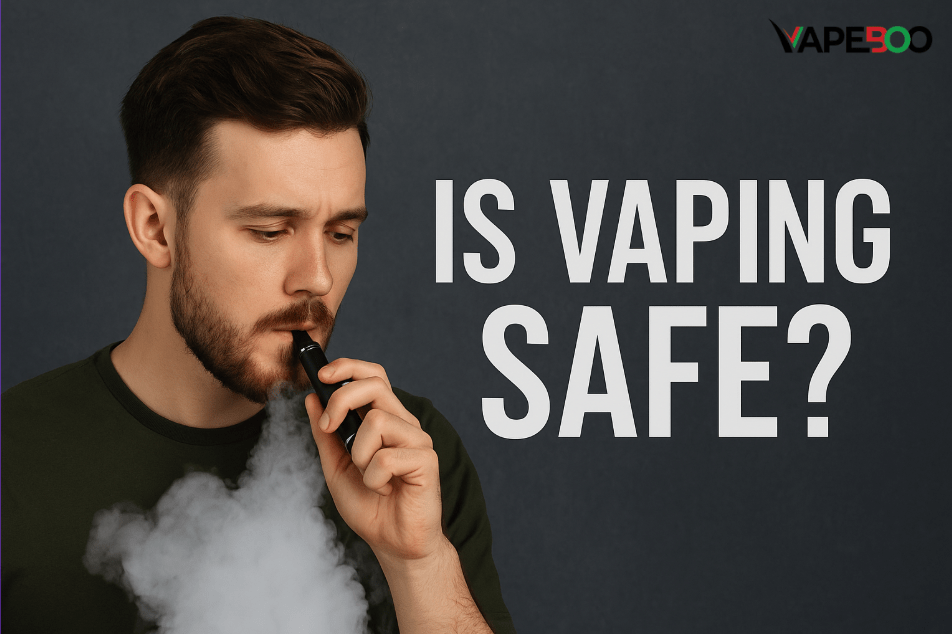Is Vaping Safe? Unveiling the Health Risks, Benefits, and Misconceptions
- by Rashid Haji

The safety of vaping remains a hot topic of debate as it continues to rise in popularity, especially as an alternative to smoking. While many consider vaping as a less harmful way to quit smoking, concerns about its potential health effects have sparked growing discussions among the public and health experts. This article explores the risks, benefits, and common misconceptions surrounding vaping, providing a balanced understanding of its implications on health.
What is Vaping?
Vaping involves inhaling vaporised eliquid through an electronic device called an e-cigarette or vape pen. These devices consist of a battery, coil, tank, and e-liquid (a blend of nicotine, propylene glycol, vegetable glycerin, and flavourings). When the coil heats up, it vaporises the liquid, producing a mist for inhalation.
Vaping has gained immense popularity, particularly as an alternative to quitting smoking. Former smokers find it appealing due to its resemblance to smoking in action but with fewer harmful chemicals. Its customizability in flavours and nicotine levels has attracted a wide user base.
What Does the Research Say About Vaping Safety?
Research on vaping’s short-term and mild health effects has primarily focused on respiratory and cardiovascular issues. Some studies indicate that vaping can lead to throat irritation, coughing, and mild inflammation in the lungs. Nicotine's stimulant effects may also cause a temporary increase in heart rate and blood pressure. However, these effects are significantly milder than the damage caused by smoking traditional cigarettes, which exposes users to harmful chemicals produced by combustion.
Vaping is a relatively new trend so its long-term studies are still limited. Researchers agree that more time and study are required to fully understand the long-term effects of vaping. Despite these uncertainties, current evidence suggests that vaping is less harmful than smoking, largely due to the absence of toxic combustion byproducts such as tar and other carcinogens. However, ongoing research is crucial in identifying any potential risks associated with prolonged use.
In terms of overall health risks, vaping is widely considered a safer alternative to smoking. Traditional cigarettes expose users to thousands of harmful chemicals, many of which are known to cause cancer, respiratory illnesses, and cardiovascular disease. By eliminating the combustion process, vaping significantly reduces exposure to these toxins. While vaping may not be completely without risk, its harm reduction potential makes it an attractive option for smokers looking to quit.
Health Risks Associated with Vaping
Respiratory Issues Associated with Vaping
Though vaping avoids many of the chemicals found in tobacco smoke, it can still cause respiratory problems in some users. Some vapers experience irritation, dry throat, and coughing. More severe cases, such as EVALI (e-cigarette or vaping product use-associated lung injury), have been linked to the use of illicit or poorly regulated products containing harmful additives. These cases highlight the importance of using reputable, well-regulated vaping products.
Cardiovascular Effects Associated with Vaping
Nicotine, the primary stimulant in most e-liquids, can impact cardiovascular health by temporarily raising heart rate and blood pressure. For individuals with pre-existing heart conditions, high levels of nicotine may pose a risk. However, the cardiovascular risks associated with vaping are significantly lower compared to smoking, as smoking introduces a range of harmful chemicals that can lead to heart disease.
Nicotine Addiction Associated with Vaping
While vaping is often used as a tool to reduce smoking, it's important to recognise nicotine’s addictive properties. For former smokers, vaping provides a less harmful way to consume nicotine. However, for non-smokers, especially young people, vaping can introduce a risk of nicotine addiction. It's essential to choose appropriate nicotine levels and monitor usage to prevent dependency. Or even they get an option to enjoy the process of vaping with zero nicotine vapes!
E-Liquid Ingredients
E-liquids generally contain four main ingredients: propylene glycol (PG), vegetable glycerin (VG), flavourings, and nicotine. These ingredients are generally considered safe for inhalation, but some flavourings have been found to produce harmful byproducts when heated. It's important for vapers to be aware of the ingredients in their e-liquids and opt for products from reputable brands to minimise risk.
Is Vaping a Safer Alternative to Smoking?
Harm Reduction
Vaping is widely marketed as safer alternative, particularly for smokers looking to quit traditional cigarettes. By eliminating the combustion process, vaping reduces exposure to harmful chemicals found in smoke, such as tar and carbon monoxide. While vaping is not completely risk-free, it offers a significantly lower health risk compared to smoking, making it a valuable option for smokers seeking to quit.
Public Health Perspective
Public health organizations generally view vaping as a safer alternative to smoking but caution against its use by non-smokers. While some organizations promote vaping as an alternative to quitting smoking, they also emphasise that more research is needed to fully understand its long-term effects. For current smokers, switching to vaping can provide significant health benefits, but for non-smokers, vaping poses unnecessary risks.
Common Misconceptions About Vaping
Vaping is Completely Harmless
One common misconception is that vaping has no health risks. While vaping is safer than smoking, it’s not entirely without potential hazards. Nicotine addiction, respiratory irritation, and exposure to certain chemicals are all concerns that vapers should be aware of. And vaping is completely safe only when you use zero nicotine vapes!
Only Smokers Should Vape
Although vaping started as a smoking cessation tool, it has become popular among non-smokers, particularly younger people. This trend raises concerns, as vaping can introduce non-smokers to nicotine and increase the risk of addiction. Vaping should be primarily viewed as a tool for harm reduction in smokers, rather than a recreational habit for non-smokers.
The Role of Regulations in Vaping Safety
Government Regulations
Vaping regulations vary by country, but most include age restrictions, product standards, and advertising limitations. These regulations aim to protect public health by ensuring that vaping products are safe and minimising their appeal to minors.
Product Safety Standards
Regulations play a crucial role in maintaining vaping safety by controlling nicotine levels, ensuring ingredient transparency, and monitoring product quality. Buying products that meet these safety standards is essential for reducing the risks associated with vaping.
The Importance of Reputable Sources
To ensure safety, it's important to purchase vaping products from trusted, regulated sources. Counterfeit or unsafe products can contain harmful substances, increasing the risk of adverse health effects.
Tips for Safe Vaping
Choosing the Right Device
Select a vaping device from a reputable brand that prioritizes safety and quality. Look for features like overcharge protection and reliable battery systems.
Monitoring Nicotine Levels
Choose a nicotine strength that matches your needs to avoid overconsumption. If you’re new to vaping, start with lower nicotine levels and gradually adjust as needed.
Proper Maintenance and Usage
Regularly clean your device and replace coils as needed to prevent malfunctions. Follow the manufacturer's instructions for safe usage and storage.
Health Monitoring
Regularly monitor your health and consult a healthcare provider if you experience any adverse effects related to vaping. It's important to stay informed and vigilant about your well-being.
Vaping, while not entirely without risks, is a safer alternative to smoking, offering smokers a less harmful way to consume nicotine. It’s essential to stay informed about vaping products and their potential health implications while making responsible choices. By understanding the risks, benefits, and misconceptions, vapers can make educated decisions that prioritize their health and safety.
Explore our wide range of high-quality vaping products on our website, all sourced from reputable and regulated brands. If you have any questions or want to share your own vaping experiences, feel free to join the conversation in the comments section!





